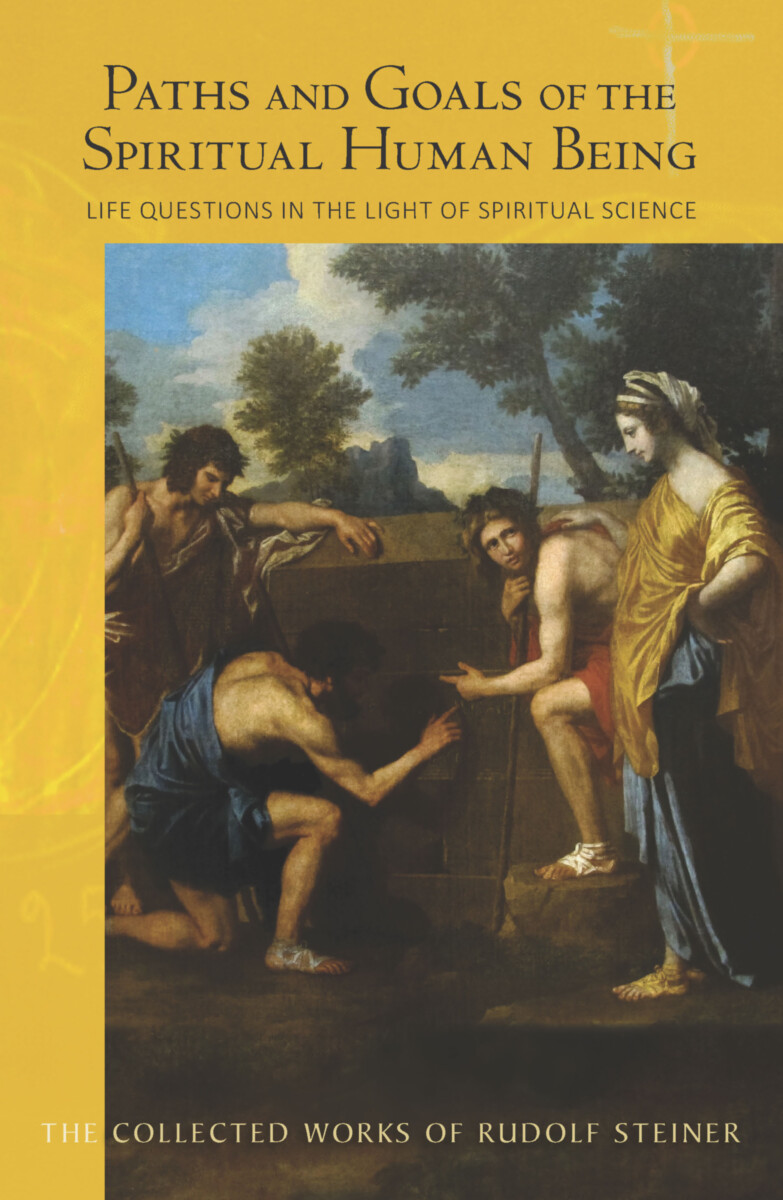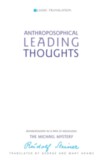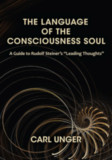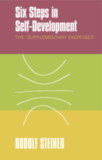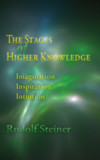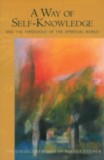Paths and Goals of the Spiritual Human Being
Life Questions in the Light of Spiritual Science (CW 125)
- Publisher
Rudolf Steiner Press - Published
15th July 2015 - ISBN 9781855844216
- Language English
- Pages 296 pp.
- Size 6" x 9"
14 lectures, various cities, January 1 – December 27, 1910 (CW 125)
Speaking to audiences in Denmark, Germany, and France, Rudolf Steiner discusses a wide range of topics—from positive and negative human soul capacities, true self-knowledge, and karma to changes in human consciousness; from ancient times to the modern era, all in the context of Christ’s incarnation on Earth.
These lectures illustrate the diversity of Steiner’s approach when speaking to different audiences. Reflecting on the polymath Novalis, for example, he is urgent about the responsibility of Spiritual Science to help humanity awaken to the New Age. A few months later, speaking of Hegel and deploring the fact that an interest in spiritual matters often fails to be accompanied by an equal interest in logical thinking, Steiner uses a dispassionate, philosophical tone. Nevertheless, throughout these lectures, he is consistent in his view that Spiritual Science does not reject conventional science. Trained, philosophical thinking leads to conclusions that are different from those of materialists, he says; but there is nothing in the field of Spiritual Science that needs to be rejected by rigorous scientific thought.
Although the lectures in this volume were given to a variety of audiences, ideas recur from different perspectives and in different contexts, with strong thematic links that hold them together. These include the relationship between philosophy and science; the nature of clairvoyance; Christ’s presence in the etheric realm; reincarnation and karma; the mystery drama The Portal of Initiation; Christmas and its symbols; and the transformation of consciousness that occurred when Christ incarnated physically on Earth.
In the final lectures, Steiner speaks inspiringly about the Christmas festival, such as the feeling of inwardness that people used to experience in contrast to the hectic cultural environment of modern cities. This, however, does not lead Steiner to nostalgia for the past; rather, he says that we should try to recreate a mood of innerness in a new way—one appropriate to our modern consciousness. These lectures offer tools to bring such a contemporary spiritual approach into our lives.
This volume is a translation from German of Wege und Ziele des geistigen Menschen. Lebensfragen im Lichte der Geisteswissenschaft (GA 125). COVER IMAGE: Et in Arcadia ego (or The Arcadian Shepherds, c.1638); by Nicolas Poussin (1594–1665), oil on canvas, 34 x 47 inches, Musée du Louvre, France
CONTENTS & SYNOPSES:
Editor’s Preface
Introduction by Christian von Arnim
1. January 23, 1910, Strasbourg: On the inauguration of the Novalis Branch. Novalis and spiritual science. The influence of Schiller and Fichte on the young Novalis. Combination of spiritual striving and sense of reality in Novalis. Inner truthfulness—the prerequisite for spiritual experience. The appearance of Christ in the etheric and the associated task of spiritual science
2. May 26, 1910, Hamburg: The philosophy of Hegel and its connection with the present time. Hegel’s youthful friendship with Schelling and Hölderlin. Grasp of the absolute idea in the Phenomenology of the Spirit and its further presentation in the. Hegel’s monism in contrast to Leibniz’s Monadology. Schelling’s theosophy. Victory of the materialistic way of thinking in the mid-nineteenth century. New methodological approaches in Solovyov and Boutroux. Strict discipline in thinking opens the path to the suprasensory.
3. June 2, 1910, Copenhagen: Paths and goals of the spiritual human being. The chasm between the modern soul and de-deified nature. The price of the conquest of the external world was desolation in the soul. Mysticism and occultism as two different types of paths to the spiritual in human beings and the world.
4. June 4, 1910, Copenhagen: External life affirms the information of the spiritual researcher. Karmic effects within the same life on earth. Overcoming egoity by the mystic. The laws of numbers, a guide for the occultist. Understanding the world from twelve different perspectives.
5. June 5, 1910, Copenhagen: Human beings live in the physical human environment. Processing of external experiences through the astral body, of extrasensory ones through the “I.” Assimilation of spiritual science through enthusiasm and love. The influence of soul processes on the aura. Guidelines on the lecture topic.
6. August 26, 1910, München: The state of philosophy and science today. The necessity of an epistemological foundation for spiritual-scientific knowledge. Greatness and weakness of Hegel’s philosophy. The path from pure thinking to suprasensory experience. The significance of the spiritual and philosophical activity of Carl Unger. Non-Euclidian geometry as an attempt to overcome the sensory world. Chapter 13 of The Philosophy of Freedom (CW 4) and its correspondence in an arithmetical formula. The mechanical theory of heat and the energy principle as examples of a misleading interpretation of scientific observations. Fertilization of physiological research through spiritual knowledge.
7. September 17, 1910, Basel: Self-knowledge following from the Rosicrucian mystery The Portal of Initiation (CW 14). The soul experiences of Johannes Thomasius, and individual manifestation of inner laws of development. True self-knowledge through immersion in other beings. Kamaloka experiences of the initiate. One’s own desires and passions experienced as beings. The difference between the aesthetic principle in Shakespear’s dramas and the spiritual realism of the Rosicrucian drama. Representation of the totality of the human being through the bearers of individual human components.
8. October 31, 1910, Berlin: Some things about the Rosicrucian mystery The Portal of Initiation. The developmental process of the Rosicrucian mystery through three-time-seven years. Karmic threads behind physical events. The individual karma of Johannes Thomasius is crossed by cosmic karma. The abandoned physical envelope is taken over by powers of the tempter. Reality and maya of the astral world. Language in the description of the nature and processes of the spiritual world.
9. November 13, 1910, Nürnberg: The wisdom of the ancient documents of the Gospels. The Christ event. The development of the world and human nature in the myths and sagas of ancient peoples. The human being as a moral soul being in the Old Testament. The inability of today’s scientific thinking to understand the handed-down evidence of an original revelation. The prerequisite for such an understanding is penetration into the events in Palestine underlying the Gospels. Empedocles and the tragedy of his knowledge and his rebirth in the modern age. Cicero, the apologist of perfect reason. The experience of St. Paul on the road to Damascus. Jesu ben Pandira, the great herald of Christ.
10. November 21, 1910, Leipzig: Imagination as the preliminary stage of higher soul abilities. Schiller and Goethe on the truth of imagination. The difference between low-level clairvoyance and spiritual-scientific knowledge. The correspondence between the world of ideas and the laws underlying the world of the senses. The development of soul forces through concentration. Rosicrucian meditation. The trained clairvoyant learns objective spiritual facts through inner images. The real basis of the imagination in the spirit.
11. November 26, 1910, Bremen: Questions of life in the light of reincarnation and karma. Diminution of the value of the human being through jealousy and lies. Jealousy is a consequence of luciferic influence on the astral body; lies a consequence of ahrimanic influence on the etheric body. Masked jealousy becomes censoriousness, suppressed mendacity becomes superficiality toward truth. Karmic consequences of jealousy and lies in the present and next incarnations. Giving help out of empathy contributes to overcoming luciferic and ahrimanic impulses in human development. The feeling of community before Christ through looking back to the common spiritual origin of humanity, and after Christ through looking at the spiritual goal of humankind.
12. December 11, 1910, München: Karmic effects. Anthroposophy as practice in life. Untruthfulness and jealousy infringe the general human characteristic of empathy. Their harmful effects on the astral body and etheric body. Negative virtues that are fought against can appear in a different form. Karmic effects of sympathy and satisfaction. The difference between the incarnations before and after the Christ event, illustrated using the individuality of Empedocles. Anthroposophy has to become practice in life.
13. December 22, 1910, Berlin: The Christmas festival in the course of time. The disharmony between the Christmas mood and the cultural environment. Last echoes of a deeper sense of meaning of the Christmas festival. Old Christmas plays in the German-language enclaves of Hungary. The descent of human beings through the Fall and their ascent again through Christ. A new Christmas mood can grow out of spiritual science.
14. December 27, 1910, Stuttgart: Yuletide, the symbols of the Christmas festival and the world-historical mood as understood by anthroposophy. The eternal comes to expression in ever new forms in the transient. The experience of the course of the year by pre-Christian populations of northern and central Europe. The festival of the Birth of Jesus as new content for the feelings. The inner connection among the Paradise play, Christmas play, and the Three Kings play. The spiritual understanding of the Christmas festival will be followed by the great Easter festival of humanity.
NotesRudolf Steiner’s Collected Works
Significant Events in the Life of Rudolf Steiner
Index
Rudolf Steiner
Rudolf Steiner (b. Rudolf Joseph Lorenz Steiner, 1861–1925) was born in the small village of Kraljevec, Austro-Hungarian Empire (now in Croatia), where he grew up. As a young man, he lived in Weimar and Berlin, where he became a well-published scientific, literary, and philosophical scholar, known especially for his work with Goethe’s scientific writings. Steiner termed his spiritual philosophy anthroposophy, meaning “wisdom of the human being.” As an exceptionally developed seer, he based his work on direct knowledge and perception of spiritual dimensions. He initiated a modern, universal “spiritual science” that is accessible to anyone willing to exercise clear and unbiased thinking. From his spiritual investigations, Steiner provided suggestions for the renewal of numerous activities, including education (general and for special needs), agriculture, medicine, economics, architecture, science, philosophy, Christianity, and the arts. There are currently thousands of schools, clinics, farms, and initiatives in other fields that involve practical work based on the principles Steiner developed. His many published works feature his research into the spiritual nature of human beings, the evolution of the world and humanity, and methods for personal development. He wrote some thirty books and delivered more than six thousand lectures throughout much of Europe. In 1924, Steiner founded the General Anthroposophical Society, which today has branches around the world.


